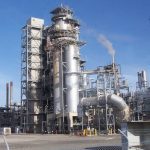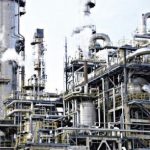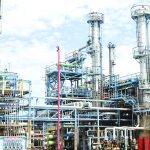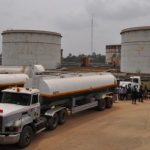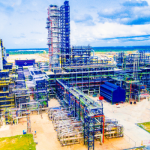Port Harcourt Refinery, located in Rivers State, Nigeria, is one of the largest in Africa.
The first refinery in Port Harcourt was commissioned in 1965 by Shell-BP. It was built to process 38,000 barrels per day of crude oil.
This refinery was established to meet domestic demand for petroleum products in Nigeria and reduce the reliance on imported refined products.

To increase the refining capacity, the federal government built a second, more modern refinery adjacent to the first.
The new Port Harcourt Refinery, had a processing capacity of 150,000 bpd, bringing the total combined capacity of both refineries to 210,000 bpd.
The new refinery was designed to process light crude and heavier crude grades for both domestic and export markets.
In 1993, the two refineries were merged into a single complex, managed by the Port Harcourt Refining Company Limited a subsidiary of the Nigerian National Petroleum Corporation as at that time.
The complex became a significant asset for Nigeria’s downstream oil sector, with the capability to produce refined products like Premium Motor Spirit, Automotive Gas Oil, dual purpose Kerosene
and Liquefied Petroleum Gas.
Over the years, the refinery faced serious operational challenges, including Frequent breakdowns, Poor maintenance, Low refining efficiency,
This made Nigeria dependent on imported refined products, despite its refining capacity.
Several efforts were made to rehabilitate the refinery through turnaround maintenance but in most cases no significant improvement was achieved.
In 2021, the Federal Government announced a major $1.5 billion rehabilitation project for the Port Harcourt Refinery, financed by loans from the African Export-Import Bank and other sources.
The project aims to restore the refinery to at least 90% of its capacity and enable it to process crude oil locally by reducing reliance on imports.
When President Bola Tinubu took over power in 2023, he promised to restore the nation’s Refinery for the country’s energy security.
NNPC Ltd. in December 2023, achieved the mechanical completion of rehabilitation work and flare start-off on Area 5 Plant of the refining company.
Since then Nigerians waited for the news of its completion.
The wait has however ended as the Nigeria National Petroleum Company Limited delivers the 60,000 barrels-per-day old Port Harcourt Refinery.
Stakeholders are filled with appreciation to President Tinubu for making this dream a reality for Nigerians.
The Old Port Harcourt Refinery is currently operating at 70% of its installed capacity, with plans to ramp up to 90%.
The refinery is producing Straight-Run Gasoline (Naphtha): Blended into 1.4 million liters of Premium Motor Spirit (PMS)
Kerosene: 900,000 liters.
Automotive Gas Oil (AGO or Diesel): 1.5 million liters.
Low Pour Fuel Oil (LPFO): 2.1 million liters.
Liquefied Petroleum Gas (LPG) Additional volumes.
The Refinery complex is divided into distinct sections designed to handle various stages of crude oil processing and refine it into usable petroleum products.
From the control room to the dispensing area activities are fully ongoing.
At the depot, trucking has commenced with several trucks on standby waiting to load.
With the successful revival of the Port Harcourt refinery, President Tinubu wants NNPC Limited to expedite the scheduled reactivation of both the second Port Harcourt refinery and the Warri and Kaduna refineries.
These efforts he says will significantly enhance domestic production capacity alongside the contributions of privately-owned refineries and make the country a major energy hub, with the gas sector also enjoying unprecedented attention by the administration.
Port Harcourt Refinery, located in Rivers State, Nigeria, is one of the largest in Africa.
The first refinery in Port Harcourt was commissioned in 1965 by Shell-BP. It was built to process 38,000 barrels per day of crude oil.
This refinery was established to meet domestic demand for petroleum products in Nigeria and reduce the reliance on imported refined products.

To increase the refining capacity, the federal government built a second, more modern refinery adjacent to the first.
The new Port Harcourt Refinery, had a processing capacity of 150,000 bpd, bringing the total combined capacity of both refineries to 210,000 bpd.
The new refinery was designed to process light crude and heavier crude grades for both domestic and export markets.
In 1993, the two refineries were merged into a single complex, managed by the Port Harcourt Refining Company Limited a subsidiary of the Nigerian National Petroleum Corporation as at that time.
The complex became a significant asset for Nigeria’s downstream oil sector, with the capability to produce refined products like Premium Motor Spirit, Automotive Gas Oil, dual purpose Kerosene
and Liquefied Petroleum Gas.
Over the years, the refinery faced serious operational challenges, including Frequent breakdowns, Poor maintenance, Low refining efficiency,
This made Nigeria dependent on imported refined products, despite its refining capacity.
Several efforts were made to rehabilitate the refinery through turnaround maintenance but in most cases no significant improvement was achieved.
In 2021, the Federal Government announced a major $1.5 billion rehabilitation project for the Port Harcourt Refinery, financed by loans from the African Export-Import Bank and other sources.
The project aims to restore the refinery to at least 90% of its capacity and enable it to process crude oil locally by reducing reliance on imports.
When President Bola Tinubu took over power in 2023, he promised to restore the nation’s Refinery for the country’s energy security.
NNPC Ltd. in December 2023, achieved the mechanical completion of rehabilitation work and flare start-off on Area 5 Plant of the refining company.
Since then Nigerians waited for the news of its completion.
The wait has however ended as the Nigeria National Petroleum Company Limited delivers the 60,000 barrels-per-day old Port Harcourt Refinery.
Stakeholders are filled with appreciation to President Tinubu for making this dream a reality for Nigerians.
The Old Port Harcourt Refinery is currently operating at 70% of its installed capacity, with plans to ramp up to 90%.
The refinery is producing Straight-Run Gasoline (Naphtha): Blended into 1.4 million liters of Premium Motor Spirit (PMS)
Kerosene: 900,000 liters.
Automotive Gas Oil (AGO or Diesel): 1.5 million liters.
Low Pour Fuel Oil (LPFO): 2.1 million liters.
Liquefied Petroleum Gas (LPG) Additional volumes.
The Refinery complex is divided into distinct sections designed to handle various stages of crude oil processing and refine it into usable petroleum products.
From the control room to the dispensing area activities are fully ongoing.
At the depot, trucking has commenced with several trucks on standby waiting to load.
With the successful revival of the Port Harcourt refinery, President Tinubu wants NNPC Limited to expedite the scheduled reactivation of both the second Port Harcourt refinery and the Warri and Kaduna refineries.
These efforts he says will significantly enhance domestic production capacity alongside the contributions of privately-owned refineries and make the country a major energy hub, with the gas sector also enjoying unprecedented attention by the administration.
Port Harcourt Refinery, located in Rivers State, Nigeria, is one of the largest in Africa.
The first refinery in Port Harcourt was commissioned in 1965 by Shell-BP. It was built to process 38,000 barrels per day of crude oil.
This refinery was established to meet domestic demand for petroleum products in Nigeria and reduce the reliance on imported refined products.

To increase the refining capacity, the federal government built a second, more modern refinery adjacent to the first.
The new Port Harcourt Refinery, had a processing capacity of 150,000 bpd, bringing the total combined capacity of both refineries to 210,000 bpd.
The new refinery was designed to process light crude and heavier crude grades for both domestic and export markets.
In 1993, the two refineries were merged into a single complex, managed by the Port Harcourt Refining Company Limited a subsidiary of the Nigerian National Petroleum Corporation as at that time.
The complex became a significant asset for Nigeria’s downstream oil sector, with the capability to produce refined products like Premium Motor Spirit, Automotive Gas Oil, dual purpose Kerosene
and Liquefied Petroleum Gas.
Over the years, the refinery faced serious operational challenges, including Frequent breakdowns, Poor maintenance, Low refining efficiency,
This made Nigeria dependent on imported refined products, despite its refining capacity.
Several efforts were made to rehabilitate the refinery through turnaround maintenance but in most cases no significant improvement was achieved.
In 2021, the Federal Government announced a major $1.5 billion rehabilitation project for the Port Harcourt Refinery, financed by loans from the African Export-Import Bank and other sources.
The project aims to restore the refinery to at least 90% of its capacity and enable it to process crude oil locally by reducing reliance on imports.
When President Bola Tinubu took over power in 2023, he promised to restore the nation’s Refinery for the country’s energy security.
NNPC Ltd. in December 2023, achieved the mechanical completion of rehabilitation work and flare start-off on Area 5 Plant of the refining company.
Since then Nigerians waited for the news of its completion.
The wait has however ended as the Nigeria National Petroleum Company Limited delivers the 60,000 barrels-per-day old Port Harcourt Refinery.
Stakeholders are filled with appreciation to President Tinubu for making this dream a reality for Nigerians.
The Old Port Harcourt Refinery is currently operating at 70% of its installed capacity, with plans to ramp up to 90%.
The refinery is producing Straight-Run Gasoline (Naphtha): Blended into 1.4 million liters of Premium Motor Spirit (PMS)
Kerosene: 900,000 liters.
Automotive Gas Oil (AGO or Diesel): 1.5 million liters.
Low Pour Fuel Oil (LPFO): 2.1 million liters.
Liquefied Petroleum Gas (LPG) Additional volumes.
The Refinery complex is divided into distinct sections designed to handle various stages of crude oil processing and refine it into usable petroleum products.
From the control room to the dispensing area activities are fully ongoing.
At the depot, trucking has commenced with several trucks on standby waiting to load.
With the successful revival of the Port Harcourt refinery, President Tinubu wants NNPC Limited to expedite the scheduled reactivation of both the second Port Harcourt refinery and the Warri and Kaduna refineries.
These efforts he says will significantly enhance domestic production capacity alongside the contributions of privately-owned refineries and make the country a major energy hub, with the gas sector also enjoying unprecedented attention by the administration.
Port Harcourt Refinery, located in Rivers State, Nigeria, is one of the largest in Africa.
The first refinery in Port Harcourt was commissioned in 1965 by Shell-BP. It was built to process 38,000 barrels per day of crude oil.
This refinery was established to meet domestic demand for petroleum products in Nigeria and reduce the reliance on imported refined products.

To increase the refining capacity, the federal government built a second, more modern refinery adjacent to the first.
The new Port Harcourt Refinery, had a processing capacity of 150,000 bpd, bringing the total combined capacity of both refineries to 210,000 bpd.
The new refinery was designed to process light crude and heavier crude grades for both domestic and export markets.
In 1993, the two refineries were merged into a single complex, managed by the Port Harcourt Refining Company Limited a subsidiary of the Nigerian National Petroleum Corporation as at that time.
The complex became a significant asset for Nigeria’s downstream oil sector, with the capability to produce refined products like Premium Motor Spirit, Automotive Gas Oil, dual purpose Kerosene
and Liquefied Petroleum Gas.
Over the years, the refinery faced serious operational challenges, including Frequent breakdowns, Poor maintenance, Low refining efficiency,
This made Nigeria dependent on imported refined products, despite its refining capacity.
Several efforts were made to rehabilitate the refinery through turnaround maintenance but in most cases no significant improvement was achieved.
In 2021, the Federal Government announced a major $1.5 billion rehabilitation project for the Port Harcourt Refinery, financed by loans from the African Export-Import Bank and other sources.
The project aims to restore the refinery to at least 90% of its capacity and enable it to process crude oil locally by reducing reliance on imports.
When President Bola Tinubu took over power in 2023, he promised to restore the nation’s Refinery for the country’s energy security.
NNPC Ltd. in December 2023, achieved the mechanical completion of rehabilitation work and flare start-off on Area 5 Plant of the refining company.
Since then Nigerians waited for the news of its completion.
The wait has however ended as the Nigeria National Petroleum Company Limited delivers the 60,000 barrels-per-day old Port Harcourt Refinery.
Stakeholders are filled with appreciation to President Tinubu for making this dream a reality for Nigerians.
The Old Port Harcourt Refinery is currently operating at 70% of its installed capacity, with plans to ramp up to 90%.
The refinery is producing Straight-Run Gasoline (Naphtha): Blended into 1.4 million liters of Premium Motor Spirit (PMS)
Kerosene: 900,000 liters.
Automotive Gas Oil (AGO or Diesel): 1.5 million liters.
Low Pour Fuel Oil (LPFO): 2.1 million liters.
Liquefied Petroleum Gas (LPG) Additional volumes.
The Refinery complex is divided into distinct sections designed to handle various stages of crude oil processing and refine it into usable petroleum products.
From the control room to the dispensing area activities are fully ongoing.
At the depot, trucking has commenced with several trucks on standby waiting to load.
With the successful revival of the Port Harcourt refinery, President Tinubu wants NNPC Limited to expedite the scheduled reactivation of both the second Port Harcourt refinery and the Warri and Kaduna refineries.
These efforts he says will significantly enhance domestic production capacity alongside the contributions of privately-owned refineries and make the country a major energy hub, with the gas sector also enjoying unprecedented attention by the administration.
Port Harcourt Refinery, located in Rivers State, Nigeria, is one of the largest in Africa.
The first refinery in Port Harcourt was commissioned in 1965 by Shell-BP. It was built to process 38,000 barrels per day of crude oil.
This refinery was established to meet domestic demand for petroleum products in Nigeria and reduce the reliance on imported refined products.

To increase the refining capacity, the federal government built a second, more modern refinery adjacent to the first.
The new Port Harcourt Refinery, had a processing capacity of 150,000 bpd, bringing the total combined capacity of both refineries to 210,000 bpd.
The new refinery was designed to process light crude and heavier crude grades for both domestic and export markets.
In 1993, the two refineries were merged into a single complex, managed by the Port Harcourt Refining Company Limited a subsidiary of the Nigerian National Petroleum Corporation as at that time.
The complex became a significant asset for Nigeria’s downstream oil sector, with the capability to produce refined products like Premium Motor Spirit, Automotive Gas Oil, dual purpose Kerosene
and Liquefied Petroleum Gas.
Over the years, the refinery faced serious operational challenges, including Frequent breakdowns, Poor maintenance, Low refining efficiency,
This made Nigeria dependent on imported refined products, despite its refining capacity.
Several efforts were made to rehabilitate the refinery through turnaround maintenance but in most cases no significant improvement was achieved.
In 2021, the Federal Government announced a major $1.5 billion rehabilitation project for the Port Harcourt Refinery, financed by loans from the African Export-Import Bank and other sources.
The project aims to restore the refinery to at least 90% of its capacity and enable it to process crude oil locally by reducing reliance on imports.
When President Bola Tinubu took over power in 2023, he promised to restore the nation’s Refinery for the country’s energy security.
NNPC Ltd. in December 2023, achieved the mechanical completion of rehabilitation work and flare start-off on Area 5 Plant of the refining company.
Since then Nigerians waited for the news of its completion.
The wait has however ended as the Nigeria National Petroleum Company Limited delivers the 60,000 barrels-per-day old Port Harcourt Refinery.
Stakeholders are filled with appreciation to President Tinubu for making this dream a reality for Nigerians.
The Old Port Harcourt Refinery is currently operating at 70% of its installed capacity, with plans to ramp up to 90%.
The refinery is producing Straight-Run Gasoline (Naphtha): Blended into 1.4 million liters of Premium Motor Spirit (PMS)
Kerosene: 900,000 liters.
Automotive Gas Oil (AGO or Diesel): 1.5 million liters.
Low Pour Fuel Oil (LPFO): 2.1 million liters.
Liquefied Petroleum Gas (LPG) Additional volumes.
The Refinery complex is divided into distinct sections designed to handle various stages of crude oil processing and refine it into usable petroleum products.
From the control room to the dispensing area activities are fully ongoing.
At the depot, trucking has commenced with several trucks on standby waiting to load.
With the successful revival of the Port Harcourt refinery, President Tinubu wants NNPC Limited to expedite the scheduled reactivation of both the second Port Harcourt refinery and the Warri and Kaduna refineries.
These efforts he says will significantly enhance domestic production capacity alongside the contributions of privately-owned refineries and make the country a major energy hub, with the gas sector also enjoying unprecedented attention by the administration.
Port Harcourt Refinery, located in Rivers State, Nigeria, is one of the largest in Africa.
The first refinery in Port Harcourt was commissioned in 1965 by Shell-BP. It was built to process 38,000 barrels per day of crude oil.
This refinery was established to meet domestic demand for petroleum products in Nigeria and reduce the reliance on imported refined products.

To increase the refining capacity, the federal government built a second, more modern refinery adjacent to the first.
The new Port Harcourt Refinery, had a processing capacity of 150,000 bpd, bringing the total combined capacity of both refineries to 210,000 bpd.
The new refinery was designed to process light crude and heavier crude grades for both domestic and export markets.
In 1993, the two refineries were merged into a single complex, managed by the Port Harcourt Refining Company Limited a subsidiary of the Nigerian National Petroleum Corporation as at that time.
The complex became a significant asset for Nigeria’s downstream oil sector, with the capability to produce refined products like Premium Motor Spirit, Automotive Gas Oil, dual purpose Kerosene
and Liquefied Petroleum Gas.
Over the years, the refinery faced serious operational challenges, including Frequent breakdowns, Poor maintenance, Low refining efficiency,
This made Nigeria dependent on imported refined products, despite its refining capacity.
Several efforts were made to rehabilitate the refinery through turnaround maintenance but in most cases no significant improvement was achieved.
In 2021, the Federal Government announced a major $1.5 billion rehabilitation project for the Port Harcourt Refinery, financed by loans from the African Export-Import Bank and other sources.
The project aims to restore the refinery to at least 90% of its capacity and enable it to process crude oil locally by reducing reliance on imports.
When President Bola Tinubu took over power in 2023, he promised to restore the nation’s Refinery for the country’s energy security.
NNPC Ltd. in December 2023, achieved the mechanical completion of rehabilitation work and flare start-off on Area 5 Plant of the refining company.
Since then Nigerians waited for the news of its completion.
The wait has however ended as the Nigeria National Petroleum Company Limited delivers the 60,000 barrels-per-day old Port Harcourt Refinery.
Stakeholders are filled with appreciation to President Tinubu for making this dream a reality for Nigerians.
The Old Port Harcourt Refinery is currently operating at 70% of its installed capacity, with plans to ramp up to 90%.
The refinery is producing Straight-Run Gasoline (Naphtha): Blended into 1.4 million liters of Premium Motor Spirit (PMS)
Kerosene: 900,000 liters.
Automotive Gas Oil (AGO or Diesel): 1.5 million liters.
Low Pour Fuel Oil (LPFO): 2.1 million liters.
Liquefied Petroleum Gas (LPG) Additional volumes.
The Refinery complex is divided into distinct sections designed to handle various stages of crude oil processing and refine it into usable petroleum products.
From the control room to the dispensing area activities are fully ongoing.
At the depot, trucking has commenced with several trucks on standby waiting to load.
With the successful revival of the Port Harcourt refinery, President Tinubu wants NNPC Limited to expedite the scheduled reactivation of both the second Port Harcourt refinery and the Warri and Kaduna refineries.
These efforts he says will significantly enhance domestic production capacity alongside the contributions of privately-owned refineries and make the country a major energy hub, with the gas sector also enjoying unprecedented attention by the administration.
Port Harcourt Refinery, located in Rivers State, Nigeria, is one of the largest in Africa.
The first refinery in Port Harcourt was commissioned in 1965 by Shell-BP. It was built to process 38,000 barrels per day of crude oil.
This refinery was established to meet domestic demand for petroleum products in Nigeria and reduce the reliance on imported refined products.

To increase the refining capacity, the federal government built a second, more modern refinery adjacent to the first.
The new Port Harcourt Refinery, had a processing capacity of 150,000 bpd, bringing the total combined capacity of both refineries to 210,000 bpd.
The new refinery was designed to process light crude and heavier crude grades for both domestic and export markets.
In 1993, the two refineries were merged into a single complex, managed by the Port Harcourt Refining Company Limited a subsidiary of the Nigerian National Petroleum Corporation as at that time.
The complex became a significant asset for Nigeria’s downstream oil sector, with the capability to produce refined products like Premium Motor Spirit, Automotive Gas Oil, dual purpose Kerosene
and Liquefied Petroleum Gas.
Over the years, the refinery faced serious operational challenges, including Frequent breakdowns, Poor maintenance, Low refining efficiency,
This made Nigeria dependent on imported refined products, despite its refining capacity.
Several efforts were made to rehabilitate the refinery through turnaround maintenance but in most cases no significant improvement was achieved.
In 2021, the Federal Government announced a major $1.5 billion rehabilitation project for the Port Harcourt Refinery, financed by loans from the African Export-Import Bank and other sources.
The project aims to restore the refinery to at least 90% of its capacity and enable it to process crude oil locally by reducing reliance on imports.
When President Bola Tinubu took over power in 2023, he promised to restore the nation’s Refinery for the country’s energy security.
NNPC Ltd. in December 2023, achieved the mechanical completion of rehabilitation work and flare start-off on Area 5 Plant of the refining company.
Since then Nigerians waited for the news of its completion.
The wait has however ended as the Nigeria National Petroleum Company Limited delivers the 60,000 barrels-per-day old Port Harcourt Refinery.
Stakeholders are filled with appreciation to President Tinubu for making this dream a reality for Nigerians.
The Old Port Harcourt Refinery is currently operating at 70% of its installed capacity, with plans to ramp up to 90%.
The refinery is producing Straight-Run Gasoline (Naphtha): Blended into 1.4 million liters of Premium Motor Spirit (PMS)
Kerosene: 900,000 liters.
Automotive Gas Oil (AGO or Diesel): 1.5 million liters.
Low Pour Fuel Oil (LPFO): 2.1 million liters.
Liquefied Petroleum Gas (LPG) Additional volumes.
The Refinery complex is divided into distinct sections designed to handle various stages of crude oil processing and refine it into usable petroleum products.
From the control room to the dispensing area activities are fully ongoing.
At the depot, trucking has commenced with several trucks on standby waiting to load.
With the successful revival of the Port Harcourt refinery, President Tinubu wants NNPC Limited to expedite the scheduled reactivation of both the second Port Harcourt refinery and the Warri and Kaduna refineries.
These efforts he says will significantly enhance domestic production capacity alongside the contributions of privately-owned refineries and make the country a major energy hub, with the gas sector also enjoying unprecedented attention by the administration.
Port Harcourt Refinery, located in Rivers State, Nigeria, is one of the largest in Africa.
The first refinery in Port Harcourt was commissioned in 1965 by Shell-BP. It was built to process 38,000 barrels per day of crude oil.
This refinery was established to meet domestic demand for petroleum products in Nigeria and reduce the reliance on imported refined products.

To increase the refining capacity, the federal government built a second, more modern refinery adjacent to the first.
The new Port Harcourt Refinery, had a processing capacity of 150,000 bpd, bringing the total combined capacity of both refineries to 210,000 bpd.
The new refinery was designed to process light crude and heavier crude grades for both domestic and export markets.
In 1993, the two refineries were merged into a single complex, managed by the Port Harcourt Refining Company Limited a subsidiary of the Nigerian National Petroleum Corporation as at that time.
The complex became a significant asset for Nigeria’s downstream oil sector, with the capability to produce refined products like Premium Motor Spirit, Automotive Gas Oil, dual purpose Kerosene
and Liquefied Petroleum Gas.
Over the years, the refinery faced serious operational challenges, including Frequent breakdowns, Poor maintenance, Low refining efficiency,
This made Nigeria dependent on imported refined products, despite its refining capacity.
Several efforts were made to rehabilitate the refinery through turnaround maintenance but in most cases no significant improvement was achieved.
In 2021, the Federal Government announced a major $1.5 billion rehabilitation project for the Port Harcourt Refinery, financed by loans from the African Export-Import Bank and other sources.
The project aims to restore the refinery to at least 90% of its capacity and enable it to process crude oil locally by reducing reliance on imports.
When President Bola Tinubu took over power in 2023, he promised to restore the nation’s Refinery for the country’s energy security.
NNPC Ltd. in December 2023, achieved the mechanical completion of rehabilitation work and flare start-off on Area 5 Plant of the refining company.
Since then Nigerians waited for the news of its completion.
The wait has however ended as the Nigeria National Petroleum Company Limited delivers the 60,000 barrels-per-day old Port Harcourt Refinery.
Stakeholders are filled with appreciation to President Tinubu for making this dream a reality for Nigerians.
The Old Port Harcourt Refinery is currently operating at 70% of its installed capacity, with plans to ramp up to 90%.
The refinery is producing Straight-Run Gasoline (Naphtha): Blended into 1.4 million liters of Premium Motor Spirit (PMS)
Kerosene: 900,000 liters.
Automotive Gas Oil (AGO or Diesel): 1.5 million liters.
Low Pour Fuel Oil (LPFO): 2.1 million liters.
Liquefied Petroleum Gas (LPG) Additional volumes.
The Refinery complex is divided into distinct sections designed to handle various stages of crude oil processing and refine it into usable petroleum products.
From the control room to the dispensing area activities are fully ongoing.
At the depot, trucking has commenced with several trucks on standby waiting to load.
With the successful revival of the Port Harcourt refinery, President Tinubu wants NNPC Limited to expedite the scheduled reactivation of both the second Port Harcourt refinery and the Warri and Kaduna refineries.
These efforts he says will significantly enhance domestic production capacity alongside the contributions of privately-owned refineries and make the country a major energy hub, with the gas sector also enjoying unprecedented attention by the administration.



